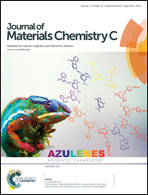Triggering DRAM/SRAM memory behaviors by single atom substitution to alter the molecular planarity†
Abstract
In this paper, two molecules (E)-6,6′-bis(benzo[b]thiophen-2-yl)-1,1′-bis(2-ethylhexyl)-[3,3′-biindolinylidene]-2,2′-dione (ID(BT)2) and (E)-6,6′-di(benzofuran-2-yl)-1,1′-bis(2-ethylhexyl)-[3,3′-biindolinylidene]-2,2′-dione (ID(BF)2) were designed and synthesized, in which isoindigo acted as the electron acceptor and benzoheterocycles acted as electron donors. The result illustrated that as the heteroatom in the benzoheterocycle was changed from O to an S atom, the intramolecular dihedral angle enlarged from 0.3° to 23°. The ID(BT)2 based device exhibited SRAM memory characteristics and the ID(BF)2 based device exhibited DRAM behaviour. The enlarged dihedral angle would prolong the process of moving back the excited electrons in the LUMO energy level to the original HOMO energy level; in other words, the ON state of the ID(BT)2 based device needs more time to return to the original OFF state and thus to exhibit SRAM performance. ID(BF)2 is almost planar and has a small barrier to impede the excited electrons from recovering to the original state, therefore the ID(BF)2 based device could return back to the OFF state in a very short time and exhibited DRAM characteristics. This is a new viewpoint for achieving different types of memory devices through changing the steric geometry and improving the intramolecular dihedral angle to impede the charge transferability.


 Please wait while we load your content...
Please wait while we load your content...